Weekend Course
High-Field to Very- & Ultra-Low-Field MRI: What's Different?
ISMRM & SMRT Annual Meeting • 15-20 May 2021

| Concurrent 3 | 13:45 - 14:30 | Moderators: Gigi Galiana & José Marques |
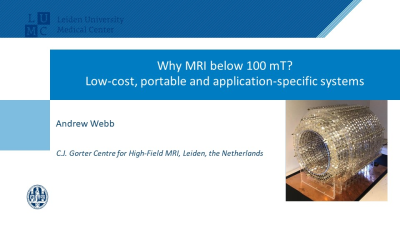 |
Why MRI Below 100 mT? Low-Cost, Portable & Application-Specific Systems
Andrew Webb
MRI systems are expensive to purchase, site, maintain and operate. This results in MRI playing a limited and last-stage role in healthcare in the developed world, and being essentially unavailable in the majority of developing countries. Lower total costs could change its fundamental role in healthcare, e.g. enabling MRI screening, portability increase the number of potential applications, and finally lower costs and more flexible designs enable systems which are application-specific, rather than one-size-fits-all, to be produced. This talk will discuss the design and performance of systems based on permanent magnets, with low-cost electronics and 3D printed components.
|
|
 |
Breaking MRI Out of Radiology: Clinical Experience & Potential for Portable & Point-of-Care Low-Field MRI
Kevin Sheth
Over the past several years, we conducted the first known deployment of a portable low field MRI in the clinical care setting at the Yale Neuroscience Intensive Care unit. This experience is the first in portable, point-of-care MRI for acute brain injury. Doing so represents a change in paradigm – moving the scanner to the patient rather moving the patient to the scanner.
|
|
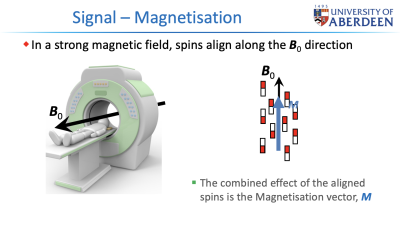 |
Contrast, Signal & Noise at Very- & Ultra-Low Versus High Field Strengths
David Lurie
In recent years, there has been renewed interest in low-field (0.2 T to 0.5 T) and very-low-field (<0.2T) MRI, for many reasons including lower cost, ease of siting, reduced hazard, portability, lower artefacts and enhanced endogenous contrast. The source of signal and its field dependence will be introduced, followed by the sources of noise (coil noise and patient noise), leading to the signal-to-noise ratio (SNR) and its dependence on magnetic field. Finally, the behaviour of contrast as a function of field will be explored, concentrating on contrast between brain grey and white matter.
|
|
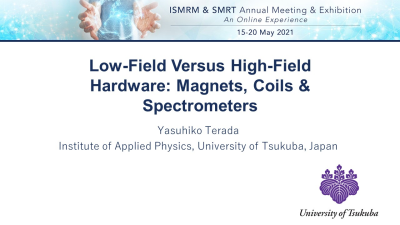 |
Low-Field Versus High-Field Hardware: Magnets, Coils & Spectrometers
Yasuhiko Terada
This talk will review the hardware of low-field MRI. The trend is to reduce the size, weight, and cost of the overall system, targeting point-of-care medicine. The Main magnet is either sparse Halbach array permanent magnet, which reduces the weight at the expensive of reduced homogeneity, or biplanar electromagnet, which have a relatively simple geometry. For pre-polarized MRI, a strong electromagnet is used for pre-polarization. For signal detection, an RF coil is preferred in the high frequency range, while SQUID sensors are used in the low frequency range. A customized, low-cost open-source console may be sufficient for low-field MRI.
|
|
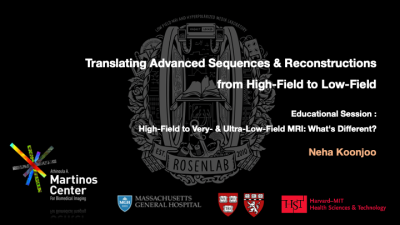 |
Translating Advanced Sequences & Reconstructions from High-Field to Low-Field
Neha Koonjoo
MR Imaging at low field (LF) suffers from low SNR due to intrinsically low Boltzmann polarization. As a result, long acquisition times are needed to accommodate the additional signal averaging required to attain sufficient SNR. In the aim of improving SNR at LF, efficient pulse sequences, efficient radiofrequency (RF) coil designs and new image reconstruction methods are required. In this talk, we will discuss how refocused pulse sequences and have enabled high-quality LF imaging. On the reconstruction side, a noise-robust image reconstruction approach AUTOMAP was implemented with a deep neural network architecture so as to further increase sensitivity at LF.
|
|
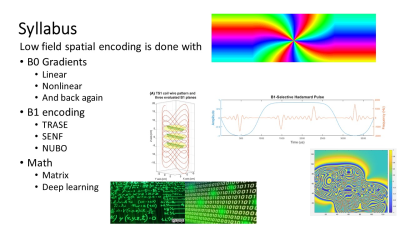 |
SAR Is No Object: Alternative Spatial Encoding Strategies for Low-Field MRI
Gigi Galiana
Low field and portable scanners have spurred a broad reimagining of spatial encoding in MRI. Many designs still use B0 variation as the primary source of spatial encoding, but these span a broader range of switchable and permanent magnet sources, with both linear and nonlinear spatial variation. In addition, the enormous reduction in SAR at low field has opened many possibilities for RF encoding, including methods based on hardware geometry, complex RF waveforms, and Bloch-Siegert evolution with hardware that allows continuous frequency encoding. Advanced reconstruction methods also play a larger role in low field imaging.
|
|
 |
More Than Just Open Magnets: Resources & Opportunities for Open-Source Hardware & Software in Low-Field MRI
Lukas Winter
Open Source Soft- and Hardware development of scientific MR methods in the construction of low-field MR technology has gained tremendous speed over the last years. As of today, it is possible to build an entire low-field MR system mostly relying on Open Source Software and Hardware designs. This is encouraging, since transparency, reproducibility and non-exclusive sharing of results are the core scientific values driving innovations and impact. In this presentation the current progress of open source low-field MR development is displayed: From pulse sequence to pulse generation hardware, amplifiers, magnets, RF and gradient coils.
|
|
| Coil Demo: What's Different About Low-Frequency Coils?
Charlotte Sappo
This talk gives an overview of some of the differences between high and low field coil considerations. The direction of the main magnetic field, often pointing either vertically or horizontally, allows us to use a solenoid, gaining a significant sensitivity boost. In this talk a demo is provided to show the winding, tuning and matching process, and general setup for constructing a solenoid. Additionally, examples of commercial and in-house built RF coils are shown that are in use on various low field systems.
|
The International Society for Magnetic Resonance in Medicine is accredited by the Accreditation Council for Continuing Medical Education to provide continuing medical education for physicians.